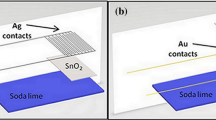The influence of electrode materials made of Ag-containing paste and Ni3B-based paste on the properties of fine SnO2 thick films is studied. The Sn0.97Sb0.03O2 nanopowder is introduced into the thick-film composite to intensify film consolidation during heat treatment, enhance film adhesion to the substrate, and control the resistivity. X-ray diffraction and electron microscopy are applied. The dependences of film resistivity on composition of the conducting phase are established. The effect of heat treatment temperature on the resistivity and current-voltage characteristics of films on silver and nickel electrodes is examined. It is shown that the electrodes made of powdered Ni3B paste can be used for SnO2 films whose heat treatment temperature does not exceed 1073 K, in particular, for gas sensors.





Similar content being viewed by others
Notes
The electrode pads made of nickel boride paste will further be referred to as nickel pads and those made of silver-containing paste as silver pads.
References
J. Fan, H. Zhao, Y. Xi, et al., “Characterization of SnO2–CoO–MnO–Nb2O5 ceramics,” J. Eur. Ceram. Soc., 30, 545–548 (2010).
S. C. Lee, S. Y. Kim, and B. W. Hwang, “Improvement of H2S sensing properties of SnO2-based thick film gas sensors promoted with MoO3 and NiO,” Sensors, 13, No. 3, 3889–3901 (2013).
K.-W. Kim, P.-S. Cho, S.-J. Kim, et al., “The selective detection of C2H5OH using SnO2–ZnO thin film gas sensors prepared by combinatorial solution deposition,” Sens. Actuators B, 123, 318–324 (2007).
J. Fan, H. Zhao, Y. Xi, et al., “Semiconducting densified SnO2-ceramics obtained by a novel sintering technique,” J. Eur. Ceram. Soc., 24, 1049–1052 (2004).
A. G. Gonchar, B. M. Rud’, A. I. Bykov, et al., “Effect of pressure–temperature treatment on the properties of antimony-doped tin dioxide, Powder Metall. Met. Ceram., 51, No. 3–4, 191–197 (2012).
M. Hosokawa, K. Nogi, M. Naito, and T. Yokoyama (eds.), Nanoparticle Technology Handbook, Elsevier, Amsterdam (2007), p. 622.
D. E. Dyshel’, “Electrophysical properties of resistive thick films based on powdered Sn0.9Sb0.1O2 and glasses with additions of LaB6,” Powder Metall. Met. Ceram., 37, No. 7–8, 438–442 (1998).
S. Ranka, S. Hafnera, N. Barsana, and U. Weimara, “The impact of the nature of the electrode material on SnO2 thick film sensor performance: influence on oxygen adsorption,” Procedia Eng., 47, 514–517 (2012).
S. M. A. Durrani, “The influence of electrode metal and its configuration on the response of tin oxide thin film CO sensor,” Talanta, 68, No. 5, 1732–1735 (2006).
S. Saukko and V. Lantto, “Influence of electrode material on properties of SnO2-based gas sensor,” Thin Solid Films, 436, No. 1, 137–140 (2003).
Yu. K. Kul’ba and B. M. Rud’, “Change in phase composition of nickel borides during heating,” Izv. Akad. Nauk SSSR. Ser. Neorg. Mater., 28, No. 5, 1116–1118 (1992).
B. M. Rud’, E. Ya. Tel’nikova, A. K. Marchuk, et al., “Production and properties of thick magnetoresistive films from fine Ni3B powders,” Powder Metall. Met. Ceram., 52, No. 5–6, 351–356 (2013).
D. E. Dyshel’ and A. A. Rogozinskaya, “Structure formation of thin-film resistance composited based on alloyed tin dioxide,” Powder Metall. Met. Ceram., 37, No. 5–6, 331–335 (1998).
G. Korotchenkov, V. Brynzari, and S. Dmitriev, “Electrical behavior of SnO2 thin films in humid atmosphere,” Sens. Actuators B, 54, 197–201 (1999).
D. E. Dyshel’, E. Ya. Tel’nikov, and L. A. Babanina, “Conductive pastes based on Ni3B on dielectric metal substrates for multilevel plates,” in: New Materials in Microelectronics [in Russian], Inst. Probl. Materialoved. AN USSR, Kiev (1991), pp. 48–52.
Author information
Authors and Affiliations
Corresponding author
Additional information
Translated from Poroshkovaya Metallurgiya, Vol. 54, Nos. 3–4 (502), pp. 96–105, 2015.
Rights and permissions
About this article
Cite this article
Gonchar, A.G., Rud’, B.M., Siman, N.I. et al. Effect of Electrode Material on the Electrical Properties of Tin Dioxide Thick Films. Powder Metall Met Ceram 54, 204–209 (2015). https://doi.org/10.1007/s11106-015-9700-0
Received:
Published:
Issue Date:
DOI: https://doi.org/10.1007/s11106-015-9700-0




